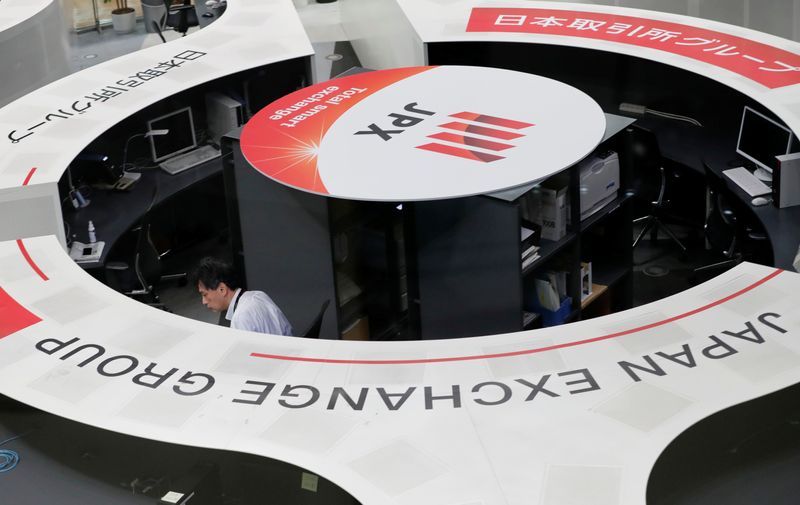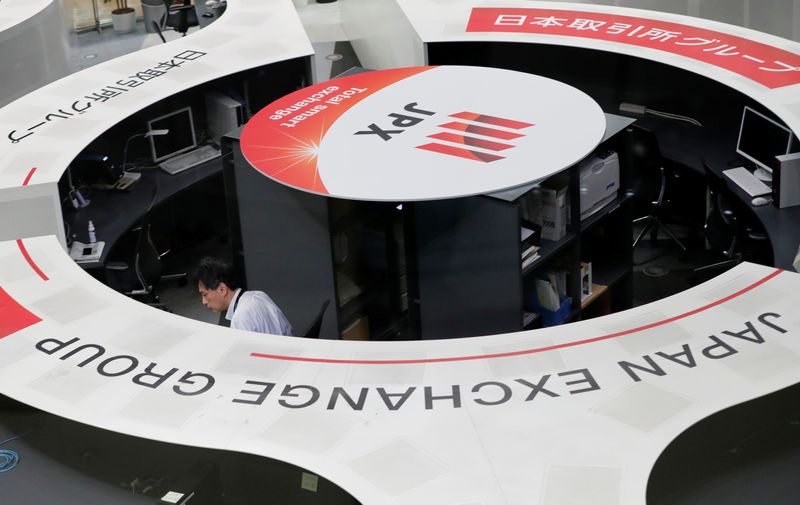Economy
Stocks, yields fall as Fed’s Powell quells rate peak bets


© Reuters. FILE PHOTO: A man works at the Tokyo Stock Exchange after market opens in Tokyo, Japan October 2, 2020. REUTERS/Kim Kyung-Hoon/File Photo
By Herbert Lash and Nell Mackenzie
NEW YORK/LONDON (Reuters) -Global equities slid and Treasury yields fell on Friday after Federal Reserve Chair Jerome Powell dashed expectations that U.S. interest rates have peaked, but stocks rose on Wall Street as eyes turned to next week’s inflation data.
Powell told an International Monetary Fund conference on Thursday the Fed would “not hesitate” to tighten monetary policy if needed and that the fight to restore price stability “had a long way to go.”
Powell’s remarks, along with a weak auction of $24 billion in 30-year Treasuries, pushed yields higher, cast a shadow on equities and helped lift the dollar on Thursday.
Many investors embraced the notion that U.S. rates have peaked after the Fed kept its overnight lending rate steady last week, a move that bolstered speculation the tightening cycle was over and spurred a short-lived rally in risky assets.
The market is waiting for next week’s consumer price index (CPI) and to a lesser extent retail sales for signs of decelerating inflation and slower consumer spending.
“We have the possibility of seeing a downside surprise” in CPI “mainly because for the headline (number) certainly gasoline prices have fallen a lot,” said Thierry Wizman, global FX and interest rates strategist at Macquarie in New York.
“We could also see some downside surprises in the core components of rents, for example, air fares, new cars, etc.”
Core CPI month-over-month is expected to have risen 0.3% in October, with a year-over-year increase of 4.1%, a Reuters poll showed. Both estimated gains are the same as in September.
“If we were to get a low CPI next week, yields can come down around that number and we may get some weakening in the dollar,” Wizman said.
MSCI’s gauge of global equity performance shed 0.02%, on track for a fourth session of losses, and the broad pan-European index lost 1.04%.
But stocks on Wall Street rose. The rose 0.39%, the gained 0.62% and the added 1%.
The two-year Treasury yield, which reflects interest rate expectations, fell 0.2 basis points to 5.020%, while the benchmark 10-year yield was down 3.2 basis points at 4.598%.
Some investors said Powell’s hawkish comments on Thursday might have been prompted by a recent softening of financial conditions after yields tumbled in recent weeks.
“The recent decline in U.S. yields has sparked questions about the necessity for the Fed to increase rates further, especially if market yields continue to adjust downward,” Bruno Schneller, managing director at INVICO Asset Management.
U.S. rate futures have priced in a roughly 60% chance of a rate cut at the Fed’s June 2024 meeting, according to the CME’s FedWatch tool, down from about 70% before Powell’s speech.
Traders would be keeping a close watch on interest rate volatility, said Schneller, noting major market fluctuations recently. “A primary cause for this volatility is the debate over whether the current Fed funds rate is overly high or insufficient.”
Asian stocks closed the day down as worries over China, the world’s second-biggest economy, resurfaced after data on Thursday showed Chinese consumer prices dipped again.
Tapas Strickland, head of market economics at NAB, said the data keeps the pressure on Beijing to continue with its incremental easing in monetary and fiscal policy.
In currency markets, the rose 0.019% to 105.91, with the euro up 0.04% to $1.067.
The Japanese yen weakened as traders remained on watch for possible intervention to shore up the struggling currency. The yen weakened 0.11% at 151.48 per dollar.
The dollar touched one-week highs against the Australian and New Zealand dollars. [FRX/]
Oil prices rose but were set to fall for a third week on signs of slowing demand and as market attention turns to a key meeting of OPEC and its allies this month, which will determine the cartel’s next move on production.
recently rose 1.7% to $77.03 per barrel and was at $81.27, up 1.57% on the day.
Gold hit an over three-week low on Friday, headed for a second straight weekly decline.
dropped 1.0% to $1,938.89 an ounce.
Economy
Russian central bank says it needs months to make sure CPI falling before rate cuts -RBC


© Reuters. Russian Central Bank Governor Elvira Nabiullina attends a news conference in Moscow, Russia June 14, 2019. REUTERS/Shamil Zhumatov/File Photo
MOSCOW (Reuters) – Russia’s central bank will need two to three months to make sure that inflation is steadily declining before taking any decision on interest rate cuts, the bank’s governor Elvira Nabiullina told RBC media on Sunday.
The central bank raised its key interest rate by 100 basis points to 16% earlier in December, hiking for the fifth consecutive meeting in response to stubborn inflation, and suggested that its tightening cycle was nearly over.
Nabiullina said it was not yet clear when exactly the regulator would start cutting rates, however.
“We really need to make sure that inflation is steadily decreasing, that these are not one-off factors that can affect the rate of price growth in a particular month,” she said.
Nabiullina said the bank was taking into account a wide range of indicators but primarily those that “characterize the stability of inflation”.
“This will take two or three months or more – it depends on how much the wide range of indicators that characterize sustainable inflation declines,” she said.
The bank will next convene to set its benchmark rate on Feb. 16.
The governor also said the bank should have started monetary policy tightening earlier than in July, when it embarked on the rate-hiking cycle.
Economy
China identifies second set of projects in $140 billion spending plan


© Reuters. FILE PHOTO: Workers walk past an under-construction area with completed office towers in the background, in Shenzhen’s Qianhai new district, Guangdong province, China August 25, 2023. REUTERS/David Kirton/File Photo
SHANGHAI (Reuters) – China’s top planning body said on Saturday it had identified a second batch of public investment projects, including flood control and disaster relief programmes, under a bond issuance and investment plan announced in October to boost the economy.
With the latest tranche, China has now earmarked more than 800 billion yuan of its 1 trillion yuan ($140 billion) in additional government bond issuance in the fourth quarter, as it focuses on fiscal steps to shore up the flagging economy.
The National Development and Reform Commission (NDRC) said in a statement on Saturday it had identified 9,600 projects with planned investment of more than 560 billion yuan.
China’s economy, the world’s second largest, is struggling to regain its footing post-COVID-19 as policymakers grapple with tepid consumer demand, weak exports, falling foreign investment and a deepening real estate crisis.
The 1 trillion yuan in additional bond issuance will widen China’s 2023 budget deficit ratio to around 3.8 percent from 3 percent, the state-run Xinhua news agency has said.
“Construction of the projects will improve China’s flood control system, emergency response mechanism and disaster relief capabilities, and better protect people’s lives and property, so it is very significant,” the NDRC said.
The agency said it will coordinate with other government bodies to make sure that funds are allocated speedily for investment and that high standards of quality are maintained in project construction.
($1 = 7.1315 renminbi)
Economy
Russian central bank says it needs months to make sure CPI falling before rate cuts -RBC


© Reuters. Russian Central Bank Governor Elvira Nabiullina attends a news conference in Moscow, Russia June 14, 2019. REUTERS/Shamil Zhumatov/File Photo
MOSCOW (Reuters) – Russia’s central bank will need two to three months to make sure that inflation is steadily declining before taking any decision on interest rate cuts, the bank’s governor Elvira Nabiullina told RBC media on Sunday.
The central bank raised its key interest rate by 100 basis points to 16% earlier in December, hiking for the fifth consecutive meeting in response to stubborn inflation, and suggested that its tightening cycle was nearly over.
Nabiullina said it was not yet clear when exactly the regulator would start cutting rates, however.
“We really need to make sure that inflation is steadily decreasing, that these are not one-off factors that can affect the rate of price growth in a particular month,” she said.
Nabiullina said the bank was taking into account a wide range of indicators but primarily those that “characterize the stability of inflation”.
“This will take two or three months or more – it depends on how much the wide range of indicators that characterize sustainable inflation declines,” she said.
The bank will next convene to set its benchmark rate on Feb. 16.
The governor also said the bank should have started monetary policy tightening earlier than in July, when it embarked on the rate-hiking cycle.

 Forex3 years ago
Forex3 years agoForex Today: the dollar is gaining strength amid gloomy sentiment at the start of the Fed’s week

 Forex3 years ago
Forex3 years agoUnbiased review of Pocket Option broker

 Forex3 years ago
Forex3 years agoDollar to pound sterling exchange rate today: Pound plummeted to its lowest since 1985

 Forex3 years ago
Forex3 years agoHow is the Australian dollar doing today?

 Cryptocurrency3 years ago
Cryptocurrency3 years agoWhat happened in the crypto market – current events today

 World3 years ago
World3 years agoWhy are modern video games an art form?

 Commodities3 years ago
Commodities3 years agoCopper continues to fall in price on expectations of lower demand in China

 Economy3 years ago
Economy3 years agoCrude oil tankers double in price due to EU anti-Russian sanctions





















